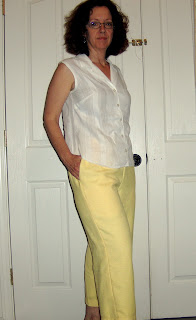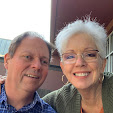
I finally got to do a little sewing this weekend. I started by making the easy pull on pants from Vogue 7883. I had some yellow linen-look fabric from JoAnns, and I thought this would make a good wearable muslin. The fabric must be polyester, because it really wanted to cling. I started with a size 12 and widened at the hip to somewhere between a 14 & 16. I always have to redraw the crotch in pants patterns to make it lower. Well, guess what? You know that line that goes horizontally between the crotch and waist that says lengthen or shorten here? That thing really does work! Why in the world I did not figure this out about 6 pairs of pants ago, I'll never know. Geez...
Anyway, the pants are great and I really like the fit. Amazingly, I did not do ANY additional alterations after cutting them out. Of course, they are, after all, elastic waist pants. We'll see what happens when I try this on regular pants!
I would have been done with these in one evening except that I realized that this fabric is far too see through. I had originally planned to underline these pants and then changed my mind. I should have stuck with the original plan. I did have some yellow cotton/poly batiste, so I used that to make a lining for these pants. I really like the way it turned out and the great thing is that they no longer cling!
Next up, the top. Now, I haven't decided whether I am doing long or short sleeves, but I know I need to get the bodice pattern fit. I usually cut out a 10, but decided this time to start with an 8. Vogue patterns seem to run big in the shoulders for me, and I have a really narrow back. Here is my dilemma: I must do a full bust adjustment. This pattern has no darts, and I really don't want to add one (although, maybe I will, still) Most FBAs require using the dart. I decided to try two different methods and compare them.
First I tried using Sandra Betzina's method in her Fast Fit book. This method requires slashing the pattern from bust point to hem, and bust point to center of shoulder. You then make 3 slashes from the armscye to the the line from bustpoint to shoulder. You then spread the pattern pieces the desired width. I spread mine 1". Then, if there is any discrepancy between the hemlines, you even them out. Also, if you want to use the original waist measurement, you angle the hem portion back to the line where you slashed it to begin with. You can see what I did here:
I actually slashed the armscye 4 times instead of 3. This is very similar to the FFRP method, but FFRP has you slash through the dart. Also, FFRP doesn't usually work for me because it also makes the pattern much wider. I didn't have a dart to work with on this one, so I didn't try the FFRP method to compare (although I could have added a dart and then rotated it out, but I'm really not into all that work. I just want to make my top!) SB's method changes the shape, but not size, of the armscye slightly (as does the FFRP method)
Next, I decided to go ahead and do my favorite Pivot and Slide method. This method is found in Nancy Zeiman's Fitting Finesse book. This is my favorite method because 1) it is easy and fast, and 2) it works!
This method involves cutting out the original pattern piece, putting it on top of another piece of paper, and then pinning and pivoting from certain points to the desired measurements. I kind of do it backwards because I don't like to cut out my pattern pieces. Also, I use see-through tracing paper and put my paper on top of the pattern instead of underneath it. This is much easier to me, faster, and uses less paper. The only thing is that when you are reading the directions, you have to do everything opposite since you are sliding the new pattern piece instead of the old one. Here is what the FBA looks like on the pivot and slide method.
Normally when I do this alteration, I also increase the dart size if there is one, or add a dart. Another advantage of this method is that it does not change the shape of the armscye or shoulder seam at all. The problem with this method and the SB method, is that they don't add any length to the front of the pattern . Since I have to adjust for a DD cup, I usually need about 1" extra length in the front. Adding that amount to the side dart puts in that added length.
Now I will show you the comparison of the two methods. The P&S pattern piece is on top and the SB pattern is on the bottom. As you can see, there is quite a bit of difference in the two. However, if you measure the armscye and the side seam in both pieces, they are exactly the same as the original pattern. Again, the problem is that neither of these methods have given me the added length in the front. I could just lengthen the center front and draw a line, but that would also increase the length of that line, and another pattern piece will be sewn to it. (in all truth, the difference turned out to be minimal, and I could have just "fudged" it, but still...)
I decided to trace the original hem line, move it down 1" and then taper up to the side. Of course, this will end up about 1/4" shy of the side seam. I then slit the pattern from hem to armscye and slid the side seam over until it met the hemline. Here is the result:
Well, that's it for tonight. I hope I actually can cut something out tomorrow, but after church, we are going up to visit my dad.
Saturday, April 19, 2008
Vogue 7883 - just starting
Posted by Nancy Winningham at 8:07 PM
Subscribe to:
Post Comments (Atom)









8 comments:
Thank you so much for the illustrations and comparison of the two fitting methods! I haven't dived too deeply into adjusting patterns to fit, and this is really helpful! :)
--Gwen
Very pretty spring pants. Thank you for the infomation and pictures on the alterations, that is so helpful
Those pants look great on you! I love the color too - so nice and springy
So pretty and springy! Whenever I make elastic waist pants, I take about 3" of ribbon, fold it in half and stitch it into the seam at center back like a tag. This really helps my children, but I find adults like it, too.
The pants look great. Good idea with the embroidery - I've been sewing a short loop of ribbon at center back when I sew down the waistband of elastic-waist pants, similar to what Summerset does.
Those pants look great on you! I love the yellow fabric.
Wow, those pants are gorgeous!
SherryV
Great pants, Nancy! They look so good on you
Post a Comment